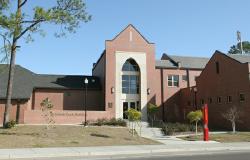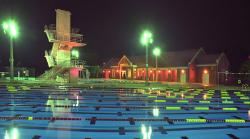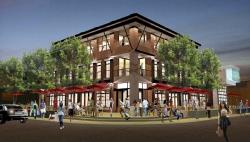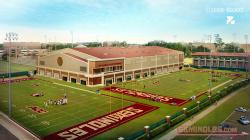Built By Boosters
Teamwork Key To Explosive Growth of Seminole Athletic Facilities
Booters have raised nearly $1 Billion since 1951 which has been invested back into Florida State Athletics
By Jim Crosby
4/2012
"I remember a time when we went to a local bank and borrowed a half million dollars to be able to pay the payroll. We had no cash
flow and had spent all our ticket revenue and Booster contributions. We didn't have a nickel."
Andy Miller, Seminole Booster president for 37 years, was reiminiscing about rough times on the road to sucess for the Seminole
athletic programs. It is hard for folks to bring that picture into focus these days.
Anyone who left Tallahassee in the 1980s and returned in 2012 would be astounded at what they see. Seminole Territory is all
grown up. State-of-the-art facilities abound. Modern, estheically pleasing, multi-functional buildings are everywhere, especially in the athletic arena.
"It is absolutely incredible. I never left, and every day when I drive to work and see the Univerity Center I shake my head in
amazement. It is just gorgeous," said Bernie Waxman, associate athletic director for Facility Planning, a 36-year employee.
How did this happen? A lot of folks rolled up their sleeves and went to work. They wrote checks, made phone calls, bought tickets
and provided shoulder-to-shoulder support for the Seminoles.
Net result? The Seminole Boosters are approaching a billion dollars raised since 1951, with every penny poured back into Florida
State athletics.
It is a stark contrast to the day of "The Erector Set," as many called Doak Campbell Stadium with its steel-supported stands. It
was built in 1950 for $250,000 and had 15,000 seats. The stadium now has with 82,300 seats and a $45,000 HD scoreboard, has undergone 15 capacity upgrades and is the
centerpiece of a $100 million University Center, a mixed-use facility that has offices, classrooms, a sports store, skyboxes, a restaurant and immense press box.
The University Center complex continues the red brick theme from the university's beginning and is believed to be the largest
continuous brick structure in America.
There is hardly a sports fan in the country who has not seen Osceola throw the flaming spear at mid-field. As Coach Jimbo Fisher
said, "Florida State is no longer just a regional or even a national team. It is international in its reach." This growth phenomenon is now reflected in its
facilities.
The key has been teamwork. Bill Carraway, Booster chairman, 1963, recalls the Booster Blitzes. "We would be assigned different
blocks and go out in teams of two, visiting businesses and soliciting membership. It cost $25 to become a Booster, which was a full day's pay for a lot of
folks."
That "one-city" team of Boosters has exploded into more than 75 cities in more than 30 states and three countries. Booster
membership numbers in excess of 16,000. In 1952, the initial Seminole Booster Group raised $397. Today the Boosters revenues from fundraising exceed $32 million
dollars per year.
In the 1970s creative strategies began to unfold that would set the stage for the dramatic growth in facilities and
scholarship endowments with record setting contributions.
Under two-term Booster Chairman George Langford and newly hired President Andy Miller, creative levels of giving were
established with associated ticket priorities. By the end of the decade, annual contributions had topped $1 million and Doak Cambell's capacity was 43,413.
In the 1980s all sports made gains. The men's basketball team left Tully Gym, built in 1956 with a seating capacity of 1,162,
and moved into the Donald Tucker Center, with its 12,100 seats.
In 1983, the Boosters headed a $1 million renovation to Seminole Baseball Stadium. In 1988, the stadium was dedicated as Dick
Howser Stadium, named for FSU's first All-American and manager of the World Champion Kansas City A's.
1991 was a landmark year. Florida State joined the Atlantic Coast Conference and began construction of the University Center,
a multi-million dollar project conceived by the Boosters, permanently changed the face of Seminole athletics and benefits academics.
Jim Pitts, the vice president of University Relations who led a feasibility study in 1987, became chairman of the University
Center building committee. He remarked about the teamwork and collaboration: "Certainly it was a significant effort on the part of the university community. The
Boosters wanted to enhance the stadium, and we wanted to have more efficient use of university property." They achieved both.
Completed in 1999, this multi-purpose structure is home to Student Services, the College of Social Work, College of Communications
and Dedman School of Hospitality. It includes the Moore Athletic Center, which houses athletic administrative offices, classroom, football locker rooms and a trophy
room.
Mark Bertolami, director of Facilities Planning, calls it an example of "strategic partnerships" and said. "What I think is
unique about FSU is that when we work on a project it is a very cooperative effort."
In 1995, Athletic Director Dave Hart was hired and brought some revealing information with him. Despite improvements, FSU
athletics was behind other major schools in many areas.
A feasibility study assessed the potential for raising $35 million dollars to launch the ambitious "Dynasty Campaign." Hart
told the "Report to Boosters Newspaper" that he saw "the working relationship between the Boosters and the athletic department staff grow closer."
The Dynasty Campaign finished with a gala celebration at which Booster Executive Director Charlie Barnes announced the final
Campaign tally as $75,311,612.72, exceeding the consultant's projection by $40 million.
Brian Swain, current Booster chairman, explained a key success factor: "No one is claiming this is my turf or this is your turf.
Everyone is just working toward a common goal."
In 2001, Seminole men and women's basketball moved into a 40,000-square-foot Basketball Training Center at the Tucker Center.
It has greatly enhanced recruiting and consolidated the basketball program in one central area.
New strategies continually evolved as the Boosters sold skyboxes, sponsorships, offered scholarship endowments and instituted
a Coach's tour to Booster clubs with VP Charlie Barnes accompanying Bobby Bowden.
One of the popular plans offered to large contributors was "Naming Options." A building or area would be named after a person or
family making a significant lead contribution. A major contribution by Mary Ann Stiles and FSU football star Barry Smith built a two-level Team Building to enhance the
newly constructed Seminole Softball and Soccer complex.
Russ Morcom, former Booster president and wife Genie, also helped fill a need after meeting with the athletic department and
learning of the need for a new swimming pool. They made the lead gift for the Morcom Aquatic Center, a $10.5 million, 10,000-square-foot building featuring an
Olympic-style pool with 30 lanes and a diving pool.
Dick Howser Stadium was renovated in 2004 for $12 million. Seating increased to 6,700 with a $150,000 scoreboard. Former
players say the stadium now rivals any minor league park and some major league stadiums.
Major donations came from former players Mike Loynd (Tradition Room) and John Ford Griffin (Clubhouse). The attractive Andy
Haggard Entry Plaza is named after the former national chairman of the Boosters, a tireless fundraiser.
Today Seminoles athletics have 20 sports and the future looks bright. In January a groundbreaking was held for College Town, a
vision to link downtown Tallahassee with the University in a "distinctive living, entertainment and dining district." It was achieved by a converting a piece of land,
donated by Shirley and DeVoe Moore who the University Center is named for.
Swain, an ardent supporter of the project, says, "We were able to take a non-earning asset and create a revenue stream that will
provide a good solid income year after year."
Coach Jimbo Fisher expressed a desire for an indoor practice facility to avoid losing practice time to the weather. That will
become a reality since Ocala businessman Al and Judy Dunlap stepped forward and presented a $5 million donation to enable construction of the facility to begin later
this year.
Booster VP of Marketing and Communications Jerry Kutz, reflecting on this exceptional success story remarked, "We are blessed
to have visionary leadership, but we also have a fan base that really cares and will write checks. When they contribute they can look at these buildings and feel
like owners. They see where their money went."
Teamwork, on and off the playing field, continues to make Florida State University an appealing place for the student athlete,
fans and supporters.
This was originally printed in the April, 2012 Unconquered Magazine. The author has given his
permission to reprint this article.



















